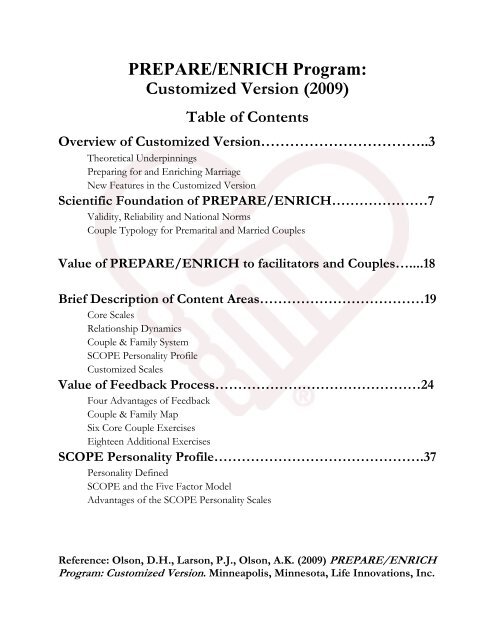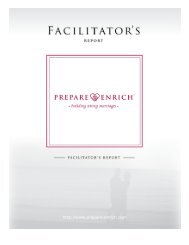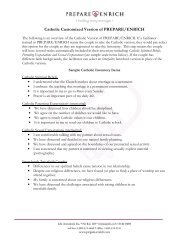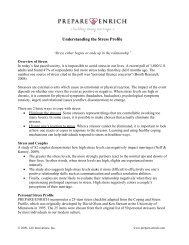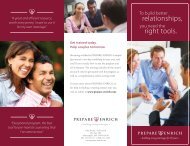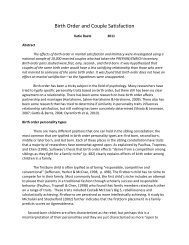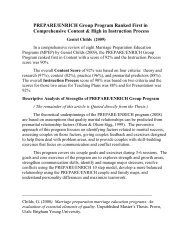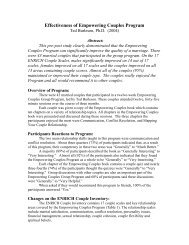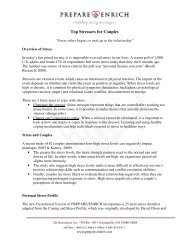PREPARE/ENRICH Program: Customized Version (2009)
PREPARE/ENRICH Program: Customized Version (2009)
PREPARE/ENRICH Program: Customized Version (2009)
Create successful ePaper yourself
Turn your PDF publications into a flip-book with our unique Google optimized e-Paper software.
<strong>PREPARE</strong>/<strong>ENRICH</strong> <strong>Program</strong>:<strong>Customized</strong> <strong>Version</strong> (<strong>2009</strong>)Table of ContentsOverview of <strong>Customized</strong> <strong>Version</strong>……………………………..3Theoretical UnderpinningsPreparing for and Enriching MarriageNew Features in the <strong>Customized</strong> <strong>Version</strong>Scientific Foundation of <strong>PREPARE</strong>/<strong>ENRICH</strong>…………………7Validity, Reliability and National NormsCouple Typology for Premarital and Married CouplesValue of <strong>PREPARE</strong>/<strong>ENRICH</strong> to facilitators and Couples…....18Brief Description of Content Areas………………………………19Core ScalesRelationship DynamicsCouple & Family SystemSCOPE Personality Profile<strong>Customized</strong> ScalesValue of Feedback Process………………………………………24Four Advantages of FeedbackCouple & Family MapSix Core Couple ExercisesEighteen Additional ExercisesSCOPE Personality Profile……………………………………….37Personality DefinedSCOPE and the Five Factor ModelAdvantages of the SCOPE Personality ScalesReference: Olson, D.H., Larson, P.J., Olson, A.K. (<strong>2009</strong>) <strong>PREPARE</strong>/<strong>ENRICH</strong><strong>Program</strong>: <strong>Customized</strong> <strong>Version</strong>. Minneapolis, Minnesota, Life Innovations, Inc.
AbstractThe <strong>Customized</strong> <strong>Version</strong> of <strong>PREPARE</strong>/<strong>ENRICH</strong> is the fifth version and the distinctive featuresare that it is online and it is tailor made to each couple. It is called the <strong>PREPARE</strong>/<strong>ENRICH</strong><strong>Program</strong> because it contains both a couple assessment and couple skill building exercises. Theprogram has 10 core scales and over 100 other scales that tap into important aspects of thecouple relationship. The goal of the program is to help increase a couples’ awareness of theirrelationship strengths and growth areas and to provide them with skills so that they can improvetheir relationship.<strong>PREPARE</strong>/<strong>ENRICH</strong> has been scientifically developed and has high reliability, high validity, andlarge national norms with couples from various ethnic groups. Numerous studies have beenpublished that demonstrate the rigor of the assessment and its relevance to couples from a varietyof ethnic groups. The program has been adopted by professional counselors from various fields(marital and family therapy, psychologists, social workers) and clergy from many diversereligious groups.The content of the <strong>Customized</strong> <strong>Version</strong> spans across many topics, allowing the couple to obtainas much helpful information about their marriage as possible. The 10 Core Scales create a baseto start the couple’s learning experience, which is then expanded upon by exploring RelationshipDynamics, Couple and Family Scales, the SCOPE Personality Profile, Stress Profile, and<strong>Customized</strong> Scales. By covering these many topics, the couple’s assessment is verycomprehensive and unique for each couple.During the feedback process, the facilitator receives a Facilitator’s Report (20-25 pages) anduses it to work with the couple. The couple is given by the facilitator their own Couple’s Report(10 pages) and Couple’s Workbook ( 25 pages) that contains couple exercises on the majorareas from the assessment. The facilitator typically uses the six core scales of<strong>PREPARE</strong>/<strong>ENRICH</strong>, as well as supplemental exercises that focus on what the couple needs mostout of the assessment process. This is just another way that both the assessment and the feedbackprocess is customized to each couple.2
OVERVIEW OF CUSTOMIZED VERSIONThe <strong>Customized</strong> <strong>Version</strong> is an innovative approach to couple assessment since it is tailor-madeto each couple. While this idea was conceived years ago, it is only with the advent of the internetthat it has become possible to create this dynamic online system. The <strong>Customized</strong> <strong>Version</strong> waslaunched in <strong>2009</strong>.The <strong>Customized</strong> <strong>Version</strong> creates the most relevant variety of scales for each couple. Instead ofthe five versions in <strong>Version</strong> 2000, there is now the potential of several hundred versions of<strong>PREPARE</strong>/<strong>ENRICH</strong> because of the unique combination of scales provided to a given couple. Inthe previous <strong>Version</strong> 2000, there were five <strong>PREPARE</strong>/<strong>ENRICH</strong> inventories were: <strong>PREPARE</strong>(for premarital couples), <strong>PREPARE</strong>—CC (for Cohabiting Couples), <strong>PREPARE</strong>—MC (forMarriage with Children), <strong>ENRICH</strong> (for married couples) and MATE (for couples over 55 yearsof age).The <strong>Customized</strong> <strong>Version</strong> is created for each couple based on background questions the coupleanswers online about their relationship. The first main category is the stage of theirrelationship—whether they are dating, engaged or married. Additional questions relate to theirage and whether there are children involved in the relationship.All couples are given several core scales and they include 10 core scales from the previousversions of <strong>PREPARE</strong>/<strong>ENRICH</strong>, the Couple and Family Map, four scales in RelationshipDynamics, five new personality scales called SCOPE and a new Personal Stress Profile. The 10core scales consist of the following: Idealistic Distortion, Communication, Conflict Resolution,Partner Style and Habits, Financial Management, Leisure Activities, Affection and Sexuality,Family and Friends, Relationship Roles, and Spiritual Beliefs.New scales that were created for the <strong>Customized</strong> <strong>Version</strong> include Cultural/Ethnic Issues,Interfaith/Interchurch, Forgiveness and a variety of scales for parenting based on the age of thechild and parenting situations (Becoming Parents, Children, Step Parenting, IntergenerationalIssues). This includes just a sample of the new scales created for the <strong>Customized</strong> <strong>Version</strong>. Acomplete list of all the scales is discussed later.Theoretical UnderpinningsThe theoretical assumption is that the quality of the marital relationship can be predicted fromthe premarital relationship. Therefore, we can identify the relationship factors that, if improved,will make a difference to the quality of a marriage (Fowers and Olson, 1986). <strong>Version</strong> 2000 of3
the <strong>PREPARE</strong>/<strong>ENRICH</strong> <strong>Program</strong> is a comprehensive premarital program which has a theoreticaland empirical foundation with clinical relevance to couples.This program applies four important characteristics of an effective preventative approach. First,factors which relate to marital success need to be identified. Second, couples need to be assessedon those critical variables. Third, feedback and exercises need to be given to couples, which willhelp them deal with problem areas. Fourth, couples need skill building exercises focusing oncommunication and conflict resolution skills. Additional couple exercises can be offered basedon the needs of the couple.An assessment and program which attempts to improve a couple’s relationship should obtaininformation on the most critical factors in premarital relationship development that are predictiveof later marital satisfaction. In a recent study, Stahmann and Hiebert (1997) identified factorswhich relate to marital success. A diverse group of 238 clergy who did premarital counselingwere asked to estimate the percentage of and premarital couples experiencing problems orcomplaints in 29 possible areas. For first marriages, the five problem areas ranked as occurringmost frequently were: communication (63%), unrealistic expectations of marriage or spouse(62%), money management/finances (60%), decision making/problem solving (55%), powerstruggles (51%). For remarriages, the five problem areas ranked as occurring most frequentlywere: communication (57%), children (57%), problems related to previous marriage (49%),power struggles (48%), and money management and finances (47%). All these topic have beensystematically integrated into <strong>PREPARE</strong>/<strong>ENRICH</strong>.Larson, Holman, Klein, Busby, Stahmann & Peterson (1995) reviewed five premaritalassessment questionnaires (PAQs) available to educators and premarital counselors. The authorsevaluated the five PAQ’s based on theoretical and psychometric criteria pertaining to theirusefulness in educational and counseling settings. Building on Larson and Holman’s (1994)previous and extensive review of literature, they evaluated each PAQ for the inclusion ofpremarital items that were found to predict future marital success. <strong>PREPARE</strong> assesses most(85%) of the premarital factors defined in their research as good predictors of marital satisfactionand stability. Based on Larson and Holmann’s evaluation of premarital assessmentquestionnaires, they found <strong>PREPARE</strong> to be “most psychometrically sound” and rated it as “thebest instrument for premarital counseling” (1995, p. 251).In summary, these reviews clearly demonstrate the importance of having a couple assessmenttool and couple program that focuses on at least the following six areas: communication, conflictresolution, family-of-origin, finances and goals. The <strong>PREPARE</strong>/<strong>ENRICH</strong> <strong>Program</strong> builds onthese important areas and provides both a couple assessment and couple exercises on thesetopics.4
Preparing for and Enriching MarriageMarriage is perhaps the most complex and challenging of all human relationships. The joining oftwo people in a relationship which is intended to last a lifetime can involve great effort todevelop and maintain. There are many benefits for those who make the commitment to marriageand manage to maintain a successful relationship. Happily married couples tend to have betterphysical and emotional health, greater financial stability and increased wealth, more sexualsatisfaction, and children that do better academically, relationally and emotionally than those ofsingle or unhappily married couples (Waite & Gallagher, 2000; Antonovics & Town, 2004;Carlson, 2006). However, getting married is still very risky since the divorce rate continues to beat about 50%. The rate of divorce increases with the number of previous marriages. The rate ofdivorce is 40% first marriages, 60% for second marriages, and 73% for third marriages.The number of people getting married is declining while and the number of cohabiting couplescontinues to increase. There were approximately 2.3 million marriages and 1.2 million divorcesin 2008. The percentage of people over 18 who are married has steadily declined, down 8%between 1970 and 2000. Cohabitation rates have risen by 1200% since the 1960’s. In 2008, itwas estimated that approximately 6.6 million couples were cohabiting, and over half of allcouples cohabited before marriage (U.S. Bureau of the Census, 2008).The divorce rates reveal that too often, couples are not equipped to deal with the challenges theyface in marriage. A significant proportion of married couples are surprised to experience seriousmarital conflicts early in their relationships.Quality premarital preparation, like <strong>PREPARE</strong>/<strong>ENRICH</strong>, can reduce the risk of divorce andincrease relationship skills and satisfaction. In a survey of 3,334 couples, premarital educationprograms were found to reduce divorce by 31% (Stanley, Amato, Johnson, & Markman, 2006).Participants with premarital education had higher marital satisfaction, higher commitment, andlower marital conflict.A meta-analysis of 13 studies of premarital programs by Carroll and Doherty (2003) foundsignificant improvement in couples who received premarital education. In a systematic study ofcouples taking the <strong>PREPARE</strong> <strong>Program</strong>, couples who participated in the program improved theircouple satisfaction and improved on 10 out of 13 areas of their relationship (Knutson & Olson,2003). For more details, go to www.prepare-enrich.com and look under “Research.” Similaroutcomes have also been found in marriage education programs. In addition to experiencingimprovement, participants report very high levels of satisfaction with these types of programsand indicate they would recommend them to other couples (Hawley and Olson, 1995).5
New Features in the <strong>Customized</strong> <strong>Version</strong>One of the new features of the <strong>Customized</strong> <strong>Version</strong> is that specialized versions were developed forvarious groups. We have different versions for various religious traditions including Protestant,Catholic, and Jewish. There is also a scale which can be selected for couples in aninterfaith/interchurch relationship.Many couples and facilitators have requested a brief report which contains some of the majorresults which the couple could review and keep. A 10 page Couple’s Report has been createdwhich includes the core categories and Couple Type, the Couple & Family Maps, the SCOPEPersonality scales, and the Personal Stress Profile.Language translations for <strong>PREPARE</strong>/<strong>ENRICH</strong> have always been a challenge, but this has beenovercome with the <strong>Customized</strong> <strong>Version</strong>. The goal is to ultimately have the <strong>Customized</strong> <strong>Version</strong>in many different languages. We have created an online translation system which will supportmultiple languages, allowing each person to take the inventory in the language they select. Thefacilitator can also choose the language in which they would like to print the Facilitator’s Report.As a companion to the <strong>Customized</strong> <strong>PREPARE</strong>/<strong>ENRICH</strong> assessments, there is a Couple’sWorkbook containing more than 20 exercises which cover 14 different content areas. In theworkbook, there are six core Couple Exercises for giving feedback to couples. These coupleexercises are designed to help the couple process and deal with the issues raised by the assessment.The six core Couple Exercises are:1. Sharing Strength and Growth Areas2. Creating a Wish List using Assertiveness & Active Listening3. Ten Steps for Resolving Conflict4. Couple & Family Map – Mapping your Relationship5. Personal Stress Profile – Identifying Most Critical Issues6. Personality Exercise – SCOPE out your PersonalityIn addition to these six couple exercises, the <strong>Customized</strong> <strong>Version</strong> contains many other exercises,many of which are new to the <strong>PREPARE</strong>/<strong>ENRICH</strong> <strong>Program</strong>. The new couple exercises includetopics related to personality, stress, roles, expectations, and stepfamilies. The wide range ofexercises allows the facilitator to further personalize the feedback experience to match the needsof each couple. These couple exercises are designed to be used in a feedback so that the couplecan resolve current issues and learn skills to deal with future issues.6
measuring the same factor. Theoretically, separate factors should emerge for each of thecategories measured.Results of factor analysis on <strong>PREPARE</strong> revealed 11 unique factors among the 12 assesseddimensions (Adaptability and Cohesion were excluded from the analysis). Personality Issues andCommunication combined to form one factor, accounting for the discrepancy. Intrascale factoranalysis revealed that most scales reflected one significant factor, supporting the unidimensionalnature of the scales. A complete description of the factor analysis is found in Fournier (1979). Ingeneral, this procedure supported the construct validity of <strong>PREPARE</strong>, although subsequentrevisions were made to further strengthen the instrument based on these findings.Predictive validity assesses the ability of an instrument to accurately predict a specific outcomelike a happy marriage or success in college. An important criterion for <strong>PREPARE</strong> is whether it isable to predict future marital happiness and stability. Two separate studies have evaluated thepredictive validity of <strong>PREPARE</strong> to distinguish between couples who are happily married andthose who are unhappily married three years after marriage. This is done by using the resultsfrom <strong>PREPARE</strong> that they completed three to four months prior to marriage.Fowers and Olson (1986) studied 164 couples recruited through clergy who used <strong>PREPARE</strong>.Couples were divided into four groups based upon their marital status and the results of a maritalsatisfaction questionnaire: married satisfied (n=59), married dissatisfied (n=22), cancelledmarriage plans (n=52) and divorced/separated (n=31).Discriminant analysis was used to determine ability to correctly classify the couples by groupusing their <strong>PREPARE</strong> scores. Using both REV and PCA Scores, <strong>PREPARE</strong> was able tocorrectly distinguish between the married-satisfied group and the other groups in 80-90 percentof the cases (separated/divorced=91%; married-dissatisfied=88%; cancelled/delayed=84%). Inother words, <strong>PREPARE</strong> scores were able to accurately identify about 80-85% of the time howhappy or unhappy a premarital couple would be 3 years after marriage.As hypothesized, significant differences were found between the married-satisfied group andseparated/divorced couples in ten scales (all except Children and Parenting), cancelled/delayedcouples in 7 scales (Realistic Expectations, Personality Issues, Communication, ConflictResolution, Sexual Relationship, Family/Friends and Equalitarian Roles) and marrieddissatisfiedcouples in 6 scales (Communication, Conflict Resolution, Leisure Activities,Financial Management, Sexual Relationship and Equalitarian Roles).Larsen and Olson (1989) replicated this study later using 179 couples divided into the same fourgroups (married satisfied, n=49; married dissatisfied, n=57; cancelled/delayed, n=37;8
separated/divorced, n=36). Analyses of variance found differences among the groups for 9 of 11scales (all except Children and Parenting and Religious Orientation). T-Tests comparing themarried-satisfied group with the separated/divorced group found significant differences for 8variables (Realistic Expectations, Personality Issues, Communication, Conflict Resolution,Leisure Activities, Family/Friends, Equalitarian Roles and Religious Orientation).Results of the discriminant analysis were similar to those of Fowers and Olson. <strong>PREPARE</strong> wasable to distinguish between the married-satisfied group and the other groups in over 80% of thecases using either PCA or REV Scores (PCA: divorced/separated = 84%; cancelled/delayed=76%; married-dissatisfied= 85%; Individual: divorced/separated= 77%; cancelled/delayed= 79%,married-dissatisfied= 75%).Both studies indicate that <strong>PREPARE</strong> has excellent predictive validity. It is able to determine wit80-85 percent accuracy couples who will tend to be satisfied with their marriages and coupleswho are likely to experience difficulties. While <strong>PREPARE</strong> is not intended to predict the maritalsuccess of specific couples, these studies do suggest that couples experiencing difficultiesidentified through the Inventory are more likely to continue problematic patterns of behaviorafter marriage unless they implement measures to change those patterns.Concurrent validity examines the relationship between a given scale and other scales which aregenerally accepted as measuring similar concepts. High correlations between the scales wouldsuggest that the instrument under consideration is an acceptable measure of the variable of focuswhen compared with an outside criterion.In a national study of 1,200 couples, Olson, McCubbin, et al. (1989) compared the MaritalSatisfaction subscale of <strong>ENRICH</strong> with the Locke-Wallace Marital Adjustment Scale—a classicmeasure of marital satisfaction. Good evidence of concurrent validity was found withcorrelations of .73 for individual scores and .81 for couple scores.When used in a clinical setting, an assessment instrument needs to have the ability to distinguishbetween functional and dysfunctional populations. Discriminant validity attempts to determinethe ability of a measure to discriminate between two or more groups by categorizing themaccording to an external criterion, then determining the extent to which the instrumentcategorizes them in the same way.Fowers and Olson (1989) did a validation study using the Marital Satisfaction item from thebackground section of <strong>ENRICH</strong> as the external criterion measure. Couples where both partnerssatisfied were placed in one group (n=2,664); couples where both partners were dissatisfied wereplaced in the other group (n=2,375). Cases with split responses were discarded from the analysis9
(n=2,222). The resulting sample was randomly split for purposes of cross-validation (validationgroup n=2,514; cross-validation group, n=2,525).Discriminant analysis was carried out on both the validation and cross-validation croups todetermine if they correctly classified satisfied from dissatisfied couples. Using individual scores,92.9 percent of the validation group and 91.7 percent of the cross-validation group were correctlyclassified. Using couple scores, 91.2 percent of the validation group and 90.1 percent of thecross-validation group were correctly classified. These analyses suggest that <strong>ENRICH</strong> as anexcellent capacity to discriminate between stressed and non-stressed couples.<strong>ENRICH</strong> also has high validity. It can discriminate with 85% accuracy between couples withmarriage problems with those who are happily married (Olson, Olson-Sigg, and Larson, 2008).High Levels of Reliability:Reliability for <strong>PREPARE</strong>/<strong>ENRICH</strong> is high in all of its scales. The following tables outline theAlpha reliability for the many scales used in the assessment across married, engaged and datingcouples. Table 1 describes the reliability for the Core Scales (alpha reliability of .60-.89).TABLE 1: Alpha Reliability of Core Scales in <strong>PREPARE</strong>/<strong>ENRICH</strong>Scale NameMarriedEngagedDating(n = 8,162)(n =16,694)(n = 3,350)Idealistic Distortion 0.88 0.80 0.85Communication 0.89 0.83 0.86Conflict Resolution 0.82 0.78 0.83Partner Style & Habits 0.89 0.85 0.88Financial Management 0.88 0.77 0.76Leisure Activities 0.82 0.79 0.81Family & Friends 0.74 0.75 0.79Roles-Responsibilities 0.85 0.64 N/ASpiritual Beliefs 0.89 0.86 0.84Children & Parenting 0.82 0.60 N/A10
Sexual Relationship 0.88 0.78 0.78Forgiveness 0.89 N/A N/AMarriage/RelationshipExpectationsN/A 0.70 0.73Character Traits N/A N/A 0.83Table 2: Alpha Reliability of Relationship Dynamics ScalesScale NameMarried(n = 8,162)Engaged(n=16,694)Dating(n=3,350)Avoidance 0.80 0.75 0.78Partner Dominance 0.85 0.82 0.85Assertiveness 0.84 0.77 0.80Self Confidence 0.80 0.77 0.78TABLE 3: Alpha Reliability of Couple and Family MapScale NameMarried(n=8,162)Engaged(n=16,694)Dating(n=3,350)Couple Closeness 0.91 0.78 0.85Couple Flexibility 0.79 0.67 0.73Family Closeness 0.91 0.91 0.91Family Flexibility 0.71 0.71 0.7011
Table 4: Alpha Reliability of SCOPE Personality ScalesScale Name Married (n=8,162) Engaged (n=16,694) Dating (n=3,350)Social 0.77 0.75 0.75Change 0.70 0.68 0.70Organized 0.75 0.73 0.72Pleasing 0.62 0.66 0.65Emotionally Steady 0.76 0.73 0.74Table 5: Alpha Reliability of the <strong>Customized</strong> ScalesScale NameMarried(n=8,162)Engaged(n=16,694)Dating(n=3,350)Intergenerational Issues 0.75 0.67 N/ACultural/Ethnic Issues 0.77 0.72 0.72Health Issues 0.81 0.77 N/ARole Transitions (Over 55) 0.89 0.82 N/ASexual Relationship (Over 55) 0.90 N/A N/ASpiritual Beliefs (Catholic) 0.85 0.85 0.87Spiritual Beliefs (Jewish) 0.76 0.78 N/ASpiritual Beliefs (Protestant) 0.87 0.90 0.86Interfaith 0.79 0.67 0.73Step Parenting (minor stepchild) 0.80 0.73 N/AParenting Expectations (no kids yet) 0.65 N/A N/AParenting Expectations (Catholic) 0.70 0.67 N/ABecoming Parents (Expecting) 0.57 0.50 N/A12
Financial Management 0.88 N/A N/ACohabitation Issues (Living together) N/A 0.70 0.82Previous Marriage (Previous divorce) N/A 0.74 N/ASexual Expectations (Catholic) N/A 0.72 N/ASexual Expectations (Protestant) N/A 0.74 N/ATable 6: Alpha Reliability for the Unique ScalesScale NameMarried(n=8,162)Engaged(n=16,694)Dating(n=3,350)Personal/Premarital Stress 0.89 0.90 0.89Abuse 0.73 0.70 0.73Commitment 0.74 0.69 0.70Couple Typology for Premarital and Married Couples<strong>PREPARE</strong> couple types are highly predictive of which couples eventually become separated/divorced, unhappily married or happily married (Fowers, Montel, and Olson, 1996). These fourtypes are called Vitalized, Harmonious, Conventional, and Conflicted (see Figure 1). Fivemarried couple types were identified using <strong>ENRICH</strong> (Olson and Fowers, 1993). The five typesare called Vitalized, Harmonious, Conventional, Conflicted, and Devitalized (see Figure 2).The couple typology was created by using the positive couple agreement (PCA) scores from the<strong>PREPARE</strong> and <strong>ENRICH</strong> Inventories using cluster analysis. Using data from 5,030 premaritalcouples who took <strong>PREPARE</strong> and 6,267 married couples who took <strong>ENRICH</strong>. It was validating tofind that the four premarital types identified from the <strong>PREPARE</strong> inventory also emerged fromthe <strong>ENRICH</strong> inventory, with one additional type (Devitalized).An important replication study of the types from <strong>ENRICH</strong> was done with a sample of 450African-American married couples was completed by William Allen (1997). Cluster analysisreplicated the same five types of couples from the Caucasian couples. This replication not onlysupported the five couple types, but the percentage of African American couples in the varioustypes were very similar to the Caucasian couples13
Figure 1. Four types of premarital couples based on <strong>PREPARE</strong>Vitalized couples: The Vitalized couples were the happiest couple type because they had thehighest positive couple agreement (PCA) scores on many of the areas. They had many strengths(high PCA scores) and few growth areas (low PCA scores).Harmonious Couples: The Harmonious couples had many strengths, but not as many as theVitalized couples. They like many areas of their relationship, but often have low scores in theChildren & Parenting area.Conventional Couples: These couples are called traditional because they had more strengths intraditional areas including Children & Parenting, Family & Friends, Traditional Roles andSpiritual Beliefs. However, they had lower scores on more internal dynamics where theyindicated problems with Personality Issues, Communication, and Conflict Resolution.Conflicted Couples: These couples had numerous growth areas and few relationship strengths.They were called conflicted since they seemed to disagree about many areas and they had lowscores on communication, conflict resolution and many of the other areas. As premaritalcouples, they are high risk for divorce and for married couples; they are a common type thatseeks marital therapy (Fowers, Montel, & Olson, 1996).14
Devitalized Couples (only from <strong>ENRICH</strong>): These couples had growth areas in almost allaspects of their relationship. They are typically very unhappy and have few strengths as acouple, although they might have had strengths earlier in their relationship. These couples arealso a common type that seeks marital therapy.Validation of the Four Premarital Types from <strong>PREPARE</strong>In order to validate the four premarital types, 328 premarital couples were followed for threeyears after marriage to assess their marital success (Fowers, Montel & Olson, 1996). These 328couples were classified into the four premarital types and outcome measures focused on whetherthey were happily married, separated/divorced and a group that canceled their wedding plans.The most significant validation of the value of the typology was the finding related to themarital outcomes of the premarital couples (see Table 7). As hypothesized, the Vitalized types ofcouples had the highest percentage of happily married couples (60%) and the lowest percentageof separated and divorced couples (17%). Conversely, the Conflicted types of couples had themost separated/divorced couples (49%) and least number of happily married couples (17%). TheTraditional types had the lowest percentage of separated/divorced couples (6%), but the highestpercentage of unhappily married couples (50%).15
Table 7 Premarital types based on <strong>PREPARE</strong> and marital outcomesPremaritalTypeHappilyMarriedN %UnhappilyMarriedN %SeparatedDivorcedN %TotalPercentN %Vitalized 38 60% 15 23% 11 17% 100%Harmonious 30 46% 19 29% 16 24% 100%Conventional 17 34% 25 50% 8 16% 100%Conflicted 10 17% 18 30% 32 49% 100%Totals 95 77 95 239There were 89 couples who canceled their wedding plans as a result of taking <strong>PREPARE</strong>and receiving feedback. As predicted, the highest percentage of those who canceled theirwedding were from Conflicted types (35 couples; 40%) followed by Traditional types (23couples; 26 %), then Harmonious types (20 couples; 22%) and least often were Vitalized types(11 couples; 12%).VALUE OF <strong>PREPARE</strong>/<strong>ENRICH</strong> TO FACILITATORS AND COUPLESThe <strong>PREPARE</strong>/<strong>ENRICH</strong> <strong>Program</strong> offers a number of advantages for facilitators and for theircouples who are completing the program.For Facilitators:• Provides a wealth of diagnostic information about a couple’s relationship.• Enhances a facilitator’s ability to work with both premarital and married couples.• Provides a detailed summary of important relationship issues.• Provides facilitator with a perspective on both “his” and “her” view of the relationshipand the amount of agreement between them.• Offers an effective and efficient way to learn more about a couple.For Couples:• Helps increase awareness of both strength and potential growth areas.• Stimulates discussion concerning issues vital to their relationship.• Primes couple for learning valuable communication and conflict resolution skills.• Functions as a preventive tool to help couples become aware of important issues beforethey turn into major problems.16
BRIEF DESCRIPTION OF CONTENT AREASEach Core and <strong>Customized</strong> scale in the inventories is made up of 10 statements, referred to as“items”, which together assess a content area of couple relationships (e.g. communication,finances). This section briefly summarizes each of the areas in the <strong>PREPARE</strong>/<strong>ENRICH</strong><strong>Customized</strong> <strong>Version</strong>. The <strong>Customized</strong> <strong>Version</strong> of <strong>PREPARE</strong>/<strong>ENRICH</strong> presents the same CoreScales to the couples who take it, regardless of the couple’s status (dating, engaged, married),unless otherwise noted.Core ScalesCommunication measures each individual’s beliefs, feelings and attitudes about communicationin his/her relationship. Items focus on the level of comfort felt by each partner in being able toshare important emotions and opinions with one another, perceptions of their partner’s listeningand speaking skills and perceptions concerning their own abilities to communicate with theirpartner.Conflict Resolution evaluates an individual’s attitudes, feelings and beliefs about the existenceand resolution of conflicts in the relationship. Items pertain to the openness of partners inrecognizing and resolving issues, the strategies and processes used to end arguments and thelevel of satisfaction with the manner in which problems are resolved.Partner Style and Habits assesses each individual’s perception and satisfaction with thepersonal habits and behavioral traits of their partner. Items focus on issues such as: temper,moodiness, and stubbornness. In addition, this scale considers a spouse’s general outlook,dependability and tendency to be controlling.Family & Friends assesses feelings and concerns about relationships with relatives, in-lawsand friends. Items focus on the attitudes of family and friends toward the marriage, expectationsregarding the amount of time spent with family and friends, comfort felt in the presence of thepartner’s family and friends and perceptions of the situation as characterized by conflict orsatisfaction.Financial Management focuses on attitudes and concerns about the way economic issues aremanaged within the couple’s relationship. Items assess the tendencies of individuals to bespenders or savers, awareness and concern with issues of credit and debts, the care with whichfinancial decisions on major purchases are made, agreement regarding financial matters, moneymanagement, and satisfaction with their economic status. There are different scale versions fordating, engaged, married, and older couples.17
Leisure Activities evaluates each individual’s preferences for using free time. Items focus onsocial versus personal activities, active versus passive interests, shared versus individualpreferences and expectations as to whether leisure time should be spent together or balancedbetween separate and joint activities.Sexual Expectations (for premarital couples)/ Sexual Relationship (for married couples)assess an individual’s feelings and concerns about affection and the sexual relationship withhis/her partner. Items reflect satisfaction with expressions of affection, level of comfort indiscussing sexual issues, attitudes toward sexual behavior, birth control/family planningdecisions and feelings about sexual fidelity.Spiritual Beliefs assesses attitudes, feelings and concerns about the meaning of religious beliefsand practices within the context of the relationship. Items focus on the meaning and importanceof religion, involvements in church/synagogue activities and the expected role religious beliefswill have in the marriage. The <strong>Customized</strong> <strong>Version</strong> offers both non-sectarian and group specific(e.g., Protestant, Catholic, Jewish etc.) versions of this scale.Marriage Expectations/Relationship Expectations assesses an individual’s expectations aboutlove, commitment and conflict in his/her relationship. The intent is to assess the degree to whichexpectations about marriage and relationships are realistic and based on objective ideas.Marriage Expectations is designed for engaged couples, while Relationship Expectations isdesigned for dating couples.Relationship Roles (engaged couples) evaluates an individual’s beliefs, attitudes and feelingsabout marital and family roles. This scale is based on numerous studies that demonstrateequalitarian roles are positively related to successful marriage in our culture.Roles & Responsibilities (married couples) evaluates an individual’s beliefs, attitudes andfeelings about marital and family roles and responsibilities. This category measures satisfactionwith how household chores and decision making are shared.Character Traits (dating couples only) measures each individual’s level of satisfaction orconcern regarding their partner’s character, values and behavior. It looks at various issuesincluding dependability, goals, priorities, and how others are treated.Forgiveness (married couples only) measures a couple’s perception of their ability to forgiveone another following a conflict, betrayal, or hurt. It looks at how well they both request andgrant forgiveness in their relationship. Taking responsibility, apologizing, re-establishing trust,and moving forward are important components of this scale.18
Relationship DynamicsFour personal and interpersonal relationship dynamics are assessed in the <strong>PREPARE</strong>/<strong>ENRICH</strong><strong>Customized</strong> <strong>Version</strong>. They are defined below:Assertiveness — a person’s ability to express his/her feelings to their partner and be able to askfor what they would like.Self Confidence — focuses on how good a person feels about himself/herself and their ability tocontrol things in their life.Avoidance — a person’s tendency to minimize issues and reluctance to deal with issues directly.Partner Dominance — focuses on how much a person feels his/her partner tries to control themand dominate his/her life.These scales are designed to increase the facilitator’s understanding of each partner and howeach partner’s characteristics are related to the underlying couple dynamics. These fourinterrelated areas together provide a rather comprehensive picture of each partner.Research has demonstrated (Olson and Olson, 2000) successful couples tend to be those inwhich both partners are high in self confidence, low in partner dominance, high in assertivenessand low in avoidance.Couple & Family SystemCouple and Family Closeness describe the level of emotional closeness experienced in a coupleand among family and the degree to which they balance togetherness and separateness. Itemsdeal with family members helping each other, spending time together and feelings of emotionalcloseness.Couple and Family Flexibility measure the ability of a couple to change and be flexible whennecessary. Items deal with leadership issues and the ability to switch responsibilities and changerules when needed.Couple & Family Map provides a pictorial representation of a couple’s relationship. Based onthe couple’s responses on closeness and flexibility, The Couple & Family map depicts therelationship between the couple and their families of origin. This will be described more in detaillater.19
SCOPE Personality ProfileThe <strong>Customized</strong> <strong>Version</strong> of <strong>PREPARE</strong>/<strong>ENRICH</strong> includes a personality section based on theFive Factor Model of Personality (Costa & McRae, 1992; Widiger & Trull, 2007). The acronymused in <strong>PREPARE</strong>/<strong>ENRICH</strong> is called SCOPE, reflecting the five personality dimensions: Social,Change, Organized, Pleasing, and Emotionally Steady. There are seven Items in each scale, allwith alpha reliability in the statistically acceptable range. The SCOPE profile will be discussedlater into more detail.Social (S) — reflects an interest in people and social activities.Change (C) — reflects openness to change, personal flexibility, and interest in newOrganized (O) — reflects how organized and persistent a person is in their daily life, work, andpursuit of goals.Pleasing (P) — reflects how considerate and cooperative a person is in their interactions withothers.Emotionally Steady (E) — reflects the tendency to stay relaxed and calm even when faced withstressful situations.<strong>Customized</strong> ScalesParenting Expectations (no children yet)/Children & Parenting (children together)measures an individual’s attitudes and feelings about having and raising children. Items reflect acouple’s awareness of the impact of children on their relationship, satisfaction with how parentalroles and responsibilities are defined, compatibility of philosophies toward discipline of children,shared goals and values desired for the children and agreement on the number of children preferred.There are distinct scale versions for couples who don’t currently have children but plan to havethem and for couples who already have children together. There are also slight modifications for theCatholic version of these scales.Step Parenting Expectations (engaged)/Step Parenting Issues (married) measures agreementon issues related to having and raising children in a stepfamily. Items reflect a couple’sawareness of the impact of children on their relationship, satisfaction with how step parentingroles and responsibilities are shared and defined, compatibility of philosophies toward disciplineof children, and agreement on how to provide for the children. There are unique Step Parentingscales for both engaged and married couples.20
Intergenerational Issues (all children over 18) focuses on how much time, money and overallinvolvement the couple feels they need to provide to their children and/or their parents. Themore a couple has resolved the issues resulting from being the “sandwich” generation, the higherthey will score in this category.Becoming Parents looks at a couple’s readiness for the transition to parenthood. This categoryexplores feelings and expectations about roles, support networks, and how the challengesassociated with caring for an infant will be managed as a couple has their first child.Interfaith/Interchurch measures how a couple from different faith traditions or churches willmanage the differences in their practice and expression of spiritual beliefs. This category looksat the capacity for individuals to be respectful and loving toward one another, despite theirdifferences. It also explores how they plan to manage their differences.Cultural/Ethnic Issues measures how concerned each individual is about differences in theirethnic or cultural background will negatively affect their relationship. This category looks at thecapacity for individuals and their families to be respectful and accepting of one another’sbackground.Health Issues (over 55) assess a couple’s level of comfort with their current health and withhow aging will affect their relationship. The more optimistic partners are about their own andtheir partner’s physical and emotional health, the higher their score will be in this area.Role Transitions (over 55) measures satisfaction with how roles and responsibilities arehandled in the relationship of older couples facing transitions. More specifically, this categorylooks at how older couples feel about managing the role transitions associated with retirement.Previous Marriage measures concern that a previous relationship could interfere with thehealth and happiness of their marriage. This scale is designed for engaged couples where one orboth partners have been previously divorced. It considers if both individuals have had enough timeto work through past hurts, understand the reasons for previous break-ups, and feel confident intheir current relationship.Cohabitation Issues evaluates each partner’s awareness of and reactions to the experience ofliving together. Items focus on how the couple has viewed cohabitation and whether theexperience has negatively affected their relationship and expectations about marriage.21
VALUE OF FEEDBACK PROCESSThe <strong>PREPARE</strong>/<strong>ENRICH</strong> Inventories have been designed so facilitators can give constructivefeedback to couples. The feedback process is designed to help facilitators work more effectivelywith couples. While we encourage facilitators to follow this process initially, you should alsofeel free to experiment and build upon it.Four Advantages of Feedback1. Completing the assessment instrument raises a natural curiosity in many couples concerning“how they did.”Couples often have concerns about whether they are “normal,” what strengths and weaknessesthe evaluation revealed and whether the assessment showed any information that may be helpfulin improving their relationship. Offering them feedback can ease any doubts and fears raised bythe assessment.2. Feedback is often a valuable piece of the change process.Through feedback, couples are made aware of the areas in most need of change. Goals maybecome clearer through the use of an assessment instrument. Couples can also become aware oftheir strengths, which will be a resource in their continued progress. In addition, couples oftenplace greater credence in the guidance from the facilitator if they are supported by an objectiveevaluation tool.3. Feedback provides a couple with insights into their relationship.Couples will typically learn a great deal about their relationship and how they each perceive it.This learning process is a valuable part of the feedback and it helps them better understand eachother. One area that couples typically enjoy discussing is their family of origin and it often givesthem greater insights into their own relationship.4. Feedback includes teaching relationship skills.Two of the most common relationship skills that are integrated into <strong>PREPARE</strong>/<strong>ENRICH</strong> areCommunication and Conflict Resolution skills. For Communication skills, we emphasize theskills of assertiveness and active listening. For conflict resolution, we have a Ten Step Model forresolving couple conflict.22
COUPLE AND FAMILY MAPTwo other relationship skills that <strong>PREPARE</strong>/<strong>ENRICH</strong> highlights are Couple Closeness andCouple Flexibility (based on the Couple Map, see Figures 3). These are two skills that couplescan learn to use more effectively in their relationship. We have provided in the Couple’sWorkbook suggestions for increasing and decreasing the levels of closeness and flexibility in acouple.Maps are Built on the Circumplex ModelThe Couple and Family Maps are based on the two key concepts of closeness and flexibility.The Maps are derived from the Circumplex Model of Marital and Family Systems, originallydeveloped by David H. Olson, Douglas Sprenkle and Candyce Russell (1980). This chapterprovides an overview of the Model including descriptions of the basic concepts and hypotheses.A comprehensive overview of the Circumplex Model can also be found at the website:www.facesiv.comHistorically, the Circumplex Model of Marital and Family Systems identified 16 types of coupleand family relationships. It was developed in an attempt to bridge a gap that typically existsamong research, theory and practice. One major approach used to bridge this gap has been thesystematic development of self-report scales based on the Circumplex Model called FACES(<strong>Version</strong>s I, II, III and IV), which is an acronym for Family Adaptability and CohesionEvaluation Scale. Over 1,000 studies have been done using FACES and it has become one of themost popular self-report scales for assessing family functioning. See www.facesiv.com for ahistorical overview and the latest updates.The Couple and Family Maps used in <strong>PREPARE</strong>/<strong>ENRICH</strong> are a revised and simplified version ofthe Circumplex Model of Marital and Family Systems. The theoretical ideas and scales used in theCouple and Family Maps are still very similar to the original Circumplex Model, which wasdeveloped for marital and family therapists and used more clinical language related to familysystem theory.Because the revised Couple and Family Maps are designed to be shared directly with couples,the Maps are simplified from the original Circumplex Model in several ways:• The descriptive terminology in the Couple and Family Maps has been simplified and theclinical terms replaced. “Closeness” replaces Cohesion and “Flexibility” replaces Adaptability.Descriptive terms related to closeness and flexibility are used instead of the clinical terms (e.g.,enmeshed, disengaged, chaotic, rigid).23
• The number of levels of cohesion and flexibility have been increased from four to five levels.Increasing the number of levels from 4 to 5 on both dimensions increased the number of types ofcouples and family systems from 16 to 25. This higher number of types provides a more accuraterepresentation of the range of normal and clinical families.• The layout has changed from a circular design to a square desigNFigure 3: Couple & Family MapCouple and Family FlexibilityFlexibility is the amount of change in leadership, role relationships and relationship rules. Thespecific concepts designed to measure flexibility include: change, leadership role sharing anddiscipline. The five levels of flexibility range from inflexible (very low) to somewhat flexible(low to moderate) to flexible (moderate) to very flexible (moderate to high) to overly flexible(very high).24
Flexibility focuses on how systems balance stability with change. As with closeness, it ishypothesized central or balanced levels of flexibility (somewhat flexible, flexible, and veryflexible) are more conducive to good couple and family functioning, with the extremes(inflexible and overly flexible) being the most problematic for couples and families as they movethrough the life cycle.Four indicators are used to assess flexibility in couples and families: change, leadership, roles,and discipline (see Map). A summary of the dynamics of balanced and unbalanced couple/familytypes is provided in the following paragraphs.Balanced couple and family systems are able to manage both stability and change. A somewhatflexible relationship tends to have democratic leadership characteristics with some negotiationsincluding the children. Roles are stable with some role sharing and rules are firmly enforced withfew changes. A flexible relationship has an equalitarian leadership with a democratic approach todecision-making. Negotiations are open and actively include the children. Roles are shared andthere is fluid change when necessary. Rules can be changed and are age appropriate. A veryflexible relationship has a tendency towards sharing in leadership and roles. Rules are veryflexible and adjusted readily when there is a need for change.Unbalanced couples and families tend to be at either the extreme of too much stability(inflexible) or too much change (overly flexible). In an inflexible relationship, one individual isin charge and is highly controlling. There tend to be limited negotiations with most decisionsimposed by the leader. Roles are strictly defined and rules do not change. An overly flexiblerelationship has erratic or limited leadership. Decisions are impulsive and not well thought out.Roles are unclear and often shift from individual to individual.In summary, very high levels of flexibility (overly flexible) and extremely low levels offlexibility (inflexible) tend to be problematic for individuals and relationship development in thelong run. Relationships having moderate scores (somewhat flexible to very flexible) are able tobalance change and stability in a more functional way.Couple and Family ClosenessCloseness is defined as the emotional bonding that couple and family members have toward oneanother. There are five levels of closeness ranging from disconnected (very low) to somewhatconnected, connected, very connected, to overly connected (very high)—see Map.It is hypothesized the three central or balanced levels of cohesion (somewhat connected, connected,and very connected) make for optimal marriage and family life. The extremes or unbalanced levels25
(disconnected or overly connected) are generally more problematic for relationships over the longterm.Closeness focuses on how systems balance separateness versus togetherness. In the model’sbalanced area of cohesion families are able to strike equilibrium moderating both separatenessand togetherness. Individuals are able to be both independent from and connected to theirfamilies.Four indicators are used to assess closeness in couples and families: separateness (I) vs.togetherness (We), closeness, loyalty, and independence vs. dependence (see Map). A summaryof the dynamic balanced and unbalanced couple/family types is provided below.Couples and families experiencing marital problems often fall into the disconnected orunbalanced areas of too much separateness. Disconnected people “do their own thing,” withlimited attachment or commitment to their relationship. When cohesion levels are very high(overly connected), there is too much consensus/emotional closeness within the family and toolittle independence.Balanced couple and family systems (somewhat connected, connected, and very connected) tendto be more functional across the life cycle. They are able to balance both the I (separateness) andthe We (togetherness) in their relationship. At the lower balanced side there is more separatenessand at the upper side more togetherness. In terms of loyalty, it increases from the somewhat tothe very connected levels. There is higher independence in somewhat connected relationshipsand higher dependence in the very connected levels. All balanced levels, however, have somedegree of interdependence.The poem “on marriage” by Kahil Gibran from The Prophet clearly describes the concept ofbalance of separateness versus togetherness.“Sing and dance together and be joyousBut let each of you be alone—Even as the strings of a lute are aloneThough they quiver with the same musicBut let there be spaces in your togethernessAnd let the winds of the heavens dance between you.”Unbalanced levels of cohesion are at the extremes of being either extremely low (disconnected)or extremely high (overly connected). A disconnected relationship often has extreme emotional26
separateness and very little closeness. There is a lack of loyalty and most people are generallyindependent. There is little involvement among family members and a great deal of personalseparateness and independence. In an overly connected relationship there is an extreme amountof emotional closeness and loyalty is demanded. Individuals are very dependent on and reactiveto one another. There is a lack of personal separateness and little private space is permitted. Theenergy of the family is focused inside the family and there are few outside individual friends.In summary, very high levels of closeness (overly connected) and very low levels of closeness(disconnected) tend to be problematic for individuals and relationship development in the longrun. On the other hand, relationships having moderate scores are able to balance being separateand together in a more functional way. Many relationships will have problems if they function ateither extreme levels for too long. Also, it is expected couple and family systems will changelevels of closeness over time.Couple and Family System TypesThe Couple and Family Map describes 25 types of couples and families. There are five levels ofcloseness and five levels of flexibility and when they are put together in the Map they create 25types. There are 9 balanced types, 12 mid-range types and 4 unbalanced types (see Map).The 9 balanced types are found in the balanced levels (3 central areas) of both closeness andflexibility. These couples and families are considered the most functional and healthy. They areable to balance both separateness versus togetherness (Closeness) and stability versus change(Flexibility).The 12 mid-range types are balanced on one dimension (closeness or flexibility) and unbalancedon the other. These couples and families generally function well until they are under stress. Thenthey often tend to slip into a more Unbalanced level.The 4 unbalanced types are found in the unbalanced levels of both closeness and flexibility.These couples and families are considered the most dysfunctional and unhealthy. They tend to bestuck at the extremes, being either “Disconnected” or “Overly connected” (Closeness) and either“Inflexible” or “Overly flexible” (Flexibility).Everybody Loves Raymond: An “Overly Connected & Inflexible” FamilyEverybody Loves Raymond revolves around Ray Barone, a successful sportswriter living onLong Island with his wife, Debra, daughter, Ally, and twin sons, Geoffrey and Michael. Ray’s27
parents, Frank and Marie, live directly across the street, which provides plenty of opportunity tointrude upon Ray’s life.Brother Robert, a divorced policeman, is constantly moving in and out of his parents’ house, andloves to drop over and resent Ray’s successful career and happy family life. His jealousy iscaptured in his belief that Marie, their mother, has always viewed Raymond as her favorite son.The family displays a great deal of enmeshment (being overly connected) in as much as Ray’sparents and brother are constantly at his house. As is typical in an enmeshed family, Debra andRay’s personal lives and relationship are often the topic of family conversation. Family membersalso have difficulty differentiating themselves from the enmeshed system. Debra hopelessly pursuesmore space and autonomy from Ray’s parents, but seldom gets it without paying the price ofMarie’s signature guilt trips.Marie is the matriarch of the family and she tries to control others, a typical pattern in a rigidsystem. In-laws have a hard time breaking into this family. The inflexibility of their system isalso seen in the inability of the boys to make any changes in their own lives or to ever go againsttheir mother’s wishes without paying a relational price.As is characteristic of an unbalanced system, the communication is poor, filled with secrets, andcharacterized by indirect messages and put-downs. In fact, you rarely see examples of positiveand healthy communication in the family.Six Core Couple ExercisesBased on past research and the expertise of the developers, these six exercises have been foundto be highly effective and important for building knowledge and relationship skills. While youmay not use all six of the core exercises with every couple, it is recommended that you includeseveral of them with each couple. The core exercises and related assessment categories include:Six Core Couple ExercisesRelevant Category1. Sharing Strength and Growth Areas .............. Overall Awareness2. Creating a Wish List using Assertiveness& Active Listening ............................ Communication3. Identifying Most Critical Issues ................. Personal Stress Profile4. Ten Steps for Resolving Conflict ................ Conflict Resolution5. Mapping Your Relationship .................... Couple and Family Maps6. SCOPE out your Personality .................... Personality28
Exercise One: Sharing Strength and Growth AreasCouples independently choose from three areas of the 12 <strong>PREPARE</strong>/ <strong>ENRICH</strong> scales that theyfeel are relationship strengths, and three areas they feel are relationship growth areas. Then eachpartner is encouraged to share what he/she believes the strengths are in their relationship. Onepartner proposes a strength area, discusses the strength, then the other partner indicates onestrength they have selected. This process is repeated until all three strength areas have beendiscussed by both partners. As partners share their perceptions, the counselor interjects theresults found in the Inventory regarding the strengths and illustrates them with some specificitems.The same discussion process is used to share and discuss growth areas. After the couple hasshared their strength and growth areas, they are encouraged to discuss questions such as, “Didyour partner’s responses surprise you?” When the partner’s perceptions concur with Inventoryresults, the counselor should interject one or two specific items from the area to generatediscussion about how the area under consideration is problematic or beneficial for the couple. Ifthe Inventory results do not concur with the partner’s perceptions, the counselor may have thecouple discuss the concern more fully with one another.Sharing strength and growth areas help the couple to understand each other better, byincreasing each other’s awareness of how they each view the relationship. This exercise alsoencourages communication, and clearly defines relationship strengths which can be built upon inthe future.Exercise Two: Creating a Wish List using Assertiveness & Active ListeningAssertiveness and Active Listening are two specific communication skills emphasized in CoupleCommunication Exercise II. By teaching assertiveness and active listening skills, it helpsincrease the positive cycle of increasing assertiveness and self-confidence and reduce thenegative cycle of avoidance and partner dominance for both the individuals and the couple(based on four personality scales).Partners each make a Wish List of three things they would like their partner to do more often andthey take turns sharing these wishes. Sharing their wishes with each other encourages eachpartner to be assertive with each other. As the couple share their wishes with each other, thecounselor provides them with feedback related to their assertiveness and active listening skills.The counselor would also give feedback from the four personality scales (Assertiveness,Avoidance, Self-Confidence, Partner Dominance) and the Communication scale. The counselorwould conclude by giving the couple positive feedback about their assertiveness and activelistening skills and how to continue to build these skills.A typical example is Susan and Michael who shared their wishes with each other. Susan askedMichael “Would you tell me more often how you are feeling and what you are thinking.”Michael said “I will try, but I will need to be reminded.” Michael had a special request for Susan29
and he said: “I wish you would be willing to come to a baseball game with me.” Susanresponded: “I will go to a game if you let me know a couple of weeks in advance so I can planfor it.” In both of these cases, the partner not only showed they understood the request, but werewilling to comply with the request. Agreeing is not a necessary step in active listening since thegoal is only to demonstrate that they understand what the other person had requested.Exercise Three: Identifying Most Critical IssuesIn this exercise, couples will identify stressors in their lives. Stressors are events that cause anemotional and/or physical reaction. Stress can be positive (wedding, jobpromotion) or negative(loss of job, car accident). This exercise will help the couple manage the many stressors, in theirlives. They will prioritize the issues that are most important to them, decide what issues can bechanged, resolved, or neither. Ultimately, the couple will become aware of and focus on the highpriority issues and those that can be changed.Exercise Four: Ten Steps for Resolving ConflictFor this exercise, the counselor would walk the couple through the Ten Steps exercise during afeedback session using an issue from one of their Growth Areas to introduce the process. Thenthe couple would select an issue to work on as a homework assignment to be reviewed at thenext session. Table 8 identifies the Ten Steps for Resolving Couple Conflict which wasdeveloped based on current research and theory regarding relevant steps that have been used in avariety of conflict resolution models.Ten steps for resolving couple conflict1. Set a time and place for discussion.2. Define the problem or issue of disagreement.3. How do each o you contribute to the problem?4. List past attempts to resolve the issue that were not successful.5. Brainstorm: List all possible solutions.6. Discuss and evaluate these possible solutions.7. Agree on one solution to try.8. Agree on how each individual will work toward this solution.9. Set up another meeting.10. Reward watch other as you each contribute toward the solution.Exercise Five: Mapping Your RelationshipUsing the Couple and Family map, the couple will compare their descriptions of their owncouple relationship, as well as compare their family of origins. They will look at the similaritiesand differences in flexibility and closeness in their families of origin. This will allow the coupleto better understand and discuss their couple relationship and families (see Figure 4).30
Figure 4 Example from Couple’s ReportCouple and Family MapCouple Closeness is defined as the emotional closeness one feels toward their partner. On thisdimension, relationships can range from disconnected to overly connected.Daniel describes this relationship as Connected. These individuals experience a healthybalance of "We" and "I", or closeness and separateness, which reflects an interdependentrelationship. Most healthy marriages not only foster connection, but also leave room for eachpartner to continue to grow and develop as individuals.Maria describes this relationship as Very Connected. Very connected couples often have agood balance of closeness and separateness, which reflects an interdependent relationship.Healthy marriages foster connection, but also leave room for each partner to pursueindividual interests and activities.31
Couple Flexibility is defined as the ability to adjust to changes in roles and leadership in response to life’sdemands. On this dimension, relationships can range from inflexible to overly flexible.Daniel feels the relationship is Somewhat Flexible, with more stability and less openness tochange. They may sometimes resist changes in leadership or roles and may need toremember that healthy relationships often require the ability to be flexible while meeting thedemands of busy lives.Maria feels the relationship is Very Flexible, with a good balance between stability andchange. They may often share decision making and are able to adjust to ongoing issues.Most couples function well with this level of flexibility.Family Closeness is defined as the emotional closeness one felt growing up in their family of origin. Onthis dimension, family relationships can range from disconnected to overly connected.Daniel grew up in a family that was Somewhat Connected. These individuals experiencedsome familycloseness, with plenty of freedom to be an individual and pursue outside relationships.Maria grew up in an Overly Connected family. These individuals often describe feeling ahigh level of closeness in their family of origin, with closeness and loyalty being thepriorities. At times they may have experienced too much connection and wished for morefreedom from their family.Family Flexibility is defined as a family’s ability to adjust to changes in roles, leadership and discipline.On this dimension, family relationships can range from inflexible to overly flexible.Daniel experienced a family of origin that felt Inflexible. These families are not very open tochange. Family members are often too rigid and resist changes in leadership, roles, androutines. These families also have trouble adjusting to stress and finding new ways to dealwith issues.Maria experienced a family of origin that felt Somewhat Flexible. These families maintain ahigh level of structure and organization. Leadership, decision-making, and roles are clearlydefined with little flexibility. They can have some difficulty adjusting to stress and findingnew ways to deal with challenges.Exercise Six: SCOPE out your PersonalityThis exercise helps the couple understand the question “Do opposites attract?” Using theirSCOPE personality profiles, the couple will discuss how their similarities and differences can bea strength or cause problems. They will also discuss if they believe that the roles they fulfill inthe relationship match their personality strengths (e.g. Does the person who scored high onorganization manage the checkbook?).32
Eighteen Additional ExercisesThere are 18 other exercises included in the workbook that have not been marked as “coreexercises”. This does not mean these exercises are less valuable for couples. In some cases, youmay want to replace a core exercise with one of the other exercises because it is more relevant tothe couple’s relationships.As time permits, consider adding 2-3 more exercises to the 6 core exercises as you providefeedback to couples. You can also select certain exercises they complete as homework betweenfeedback sessions. The remaining exercises and the related assessment categories are listedbelow:Eighteen Additional Couple ExercisesRelevant CategoryDaily Dialogue and Daily Compliments .....................CommunicationBalancing your Priorities .................................Personal Stress ProfileWedding Stress ..........................................Personal Stress ProfileHow to Take a Time-Out .................................Conflict ResolutionSeeking and Granting Forgiveness .........................ConflictResolution/ForgivenessBudget Worksheet ....................................... Financial ManagementThe Meaning of Money ................................... Financial ManagementThe Dating Exercise .....................................Leisure ActivitiesThe Foundation for Intimacy ..............................Sex and AffectionSharing Roles ...........................................Relationship RolesYour Spiritual Journey ...................................Spiritual BeliefsManaging your Expectations ..............................Marriage ExpectationsPlanning to Have Children ................................Parenting ExpectationsPlanning a Weekly Family Conference ......................Children and ParentingStepfamilies: Choosing Realistic Expectations .............................Children and ParentingCloseness Exercise.......................................Couple and Family MapsFlexibility Exercise.......................................Couple and Family MapsAchieving your Goals Together ............................Overall Goal setting33
SCOPE PERSONALITY PROFILEPersonality DefinedPersonality can be thought of as the characteristics of a person that lead to consistent patterns offeeling, thinking and behaving (Pervin and John, 2001). This definition, while simple, generallyprovides a good framework from which to understand personality.Counselors who adequately understand personality are better able to predict how certainindividuals will typically respond to others, to conflict and to life in general. Different views ofpersonality allow researchers and counselors to funnel large amounts of information about anindividual into smaller, more digestible terminology that offer useful descriptions of behaviorand functioning.An important aspect of personality is that it tends to be relatively stable over time. A commonmisperception is you can change personality traits if you don’t like them. While one mightachieve slight adjustments in personality over time, personality traits are largely stablethroughout life.For couples, this means a person should not try or expect his/her partner to change theirpersonality traits. Relationship skills can be learned and improved. An individual can learn tocommunicate or manage finances more effectively. But an extrovert should not be expected tosomehow become an introvert. Couples who set out to change one another’s personality willembark on a journey of frustration.No matter how much a couple has in common, it is impossible two individuals would think, feel,and behave in exactly the same ways. Not only are there gender and background differences, butevery personality is unique. Exploring personality similarities and differences can be afascinating and fun process. There are no “right” or “wrong” combination of personality traits fora successful relationship, but some couples face more challenges as they have very differentpreferences in their approach to life.SCOPE and the Five Factor ModelThe <strong>Customized</strong> <strong>Version</strong> of <strong>PREPARE</strong>/<strong>ENRICH</strong> includes a personality section based on asimplified expression of the Five Factor Model of Personality, considered the most robust andcommonly referenced personality assessment framework in current psychological literature(Costa & McRae, 1992; Goldberg, 1990;Widiger & Trull, 2007).34
The “Big Five” refers to the five most documented aspects of personality functioning andcommonly remembered using the acronym OCEAN. Unlike other personality approaches,which begin with a theoretical model of how personality is organized and then construct amatching assessment, the Big Five approach began with no theory in mind. Instead, researchersconducted statistical analysis of every adjective in the English language to see what patterns or“factors” emerged. The resulting five factors have now been replicated in many other languagesand cultures.The SCOPE acronym consists of five scales: Social, Change, Organized, Pleasing andEmotionally Steady. SCOPE is used in <strong>PREPARE</strong>/<strong>ENRICH</strong> instead of the Big Five OCEANacronym since the names of the scales were changed to make the language more accessible andmemorable. The SCOPE categories are positive and easy to remember: Non-clinical languagewas purposefully used in naming each category to make the scale more understandable to ageneral population. Clinicians and academicians can rest assured the SCOPE is based on awealth of personality research done on the Big Five model.One aspect of the SCOPE Personality scales that is unique is the possibility for a person to scorehigh on all five scales or low on all five scales. This demonstrates the scales are empirically andpractically independent of each other.Advantages of the SCOPE Personality Scales• SCOPE is built on years of empirical research• The acronym SCOPE is easily remembered by counselors and couples alike• The intentional usage of non-clinical language makes the subscales easily understood• The scales are geared in a positive direction, allowing couples and facilitators to focuson strengths instead of weaknesses• The subscales are easily explained to and understood by couples with no previousexposure to personality assessment• The SCOPE scales correspond closely with the Big Five Model, so researchers andcounselors familiar with this terminology can easily switch between models• SCOPE allows easy comparison between various personality modelsTable 9 provides a more detailed operational definition of each of the five scales in SCOPE. Foreach scale, there is an interpretation for a high and low score on that scale. For example, on theSocial scale, a high score indicates an extrovert and a low score indicates an introvert. Some ofthe primary descriptors for persons scoring high on these scales are also provided.35
Table 9 High Scores Interpretations of SCOPE Scales36


